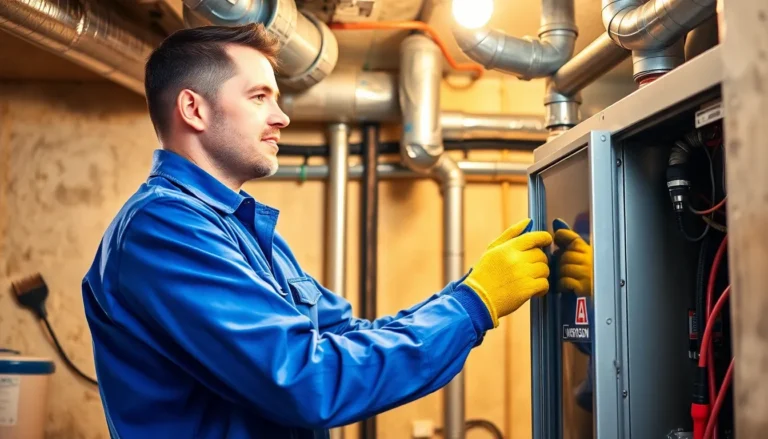Table of Contents
ToggleIn today’s world, reliable power is essential for both homes and businesses. As outages become more frequent, many are turning to generator installation as a smart solution. A well-installed generator not only keeps the lights on but also ensures that essential appliances and systems continue to function during emergencies.
Choosing the right generator and understanding the installation process can feel overwhelming. However, with the right guidance, anyone can navigate this crucial decision. From selecting the appropriate size to understanding local codes, generator installation is a vital investment in peace of mind and safety.
Importance Of Generator Installation
Generator installation serves a crucial role in ensuring uninterrupted power supply. It maintains functionality when public electricity fails, providing essential services for homes and businesses. By installing a generator, individuals can safeguard against the damages caused by power outages.
Proper generator installation enhances safety and efficiency. An inadequately installed generator poses risks, including potential fires, carbon monoxide poisoning, or equipment damage. Reliable installation mitigates these dangers, ensuring safe operation in emergency situations.
Generator installations offer versatility. They supply backup power for various applications, from essential home appliances like refrigerators and medical equipment to business operations demanding continuous electricity, like data centers and manufacturing facilities. This versatility makes generator installation a wise investment.
Cost-effective benefits accompany secure installations. With a generator, individuals reduce losses caused by downtime or spoiled goods during outages. Long-term savings often outweigh the initial installation expenses, reinforcing the importance of making informed decisions during the selection process.
Generator installation acts as a vital measure for maintaining power during outages, enhancing safety, providing versatility, and delivering long-term savings.
Types Of Generators

Generators come in various types, each tailored for specific power needs and usage scenarios. Understanding these types aids in selecting the right generator for effective installation.
Portable Generators
Portable generators provide temporary power solutions, ideal for outdoor activities or emergency backup. They typically run on gasoline, propane, or diesel, offering flexibility and mobility. Common uses include powering tools at construction sites and providing electricity during outages. Portable generators typically range from 1,000 to 7,500 watts, making them suitable for running essential appliances like refrigerators, lights, and small heaters. It’s important to use these generators outside to avoid carbon monoxide buildup.
Standby Generators
Standby generators serve as permanent fixtures, automatically supplying power when grid electricity fails. These generators connect directly to a home’s electrical system and run on natural gas or propane, ensuring a steady power source. Standby generators often range from 5,000 to 20,000 watts, capable of powering entire homes or businesses. Their installation involves integrating transfer switches, allowing seamless operation during outages. Standby generators’re essential for maintaining comfort and functionality in critical systems, such as heating, cooling, and emergency lighting.
Key Factors To Consider
Several critical factors influence generator installation. Understanding these elements ensures optimal performance and safety during use.
Location And Placement
Choosing the right location for a generator is essential for functionality and safety. Install the generator on a level, stable surface while ensuring adequate clearance from walls, windows, and doors. Position the generator at least 5 feet away from structures to minimize the risk of fire hazards and ensure proper ventilation. Consider environmental factors, such as drainage and potential flooding, when selecting the installation site.
Fuel Source
Selecting an appropriate fuel source impacts generator performance and efficiency. Common options include gasoline, propane, and natural gas.
- Gasoline: Easily accessible and convenient for portable generators, gasoline has a limited shelf life and requires careful storage.
- Propane: Offers longer storage stability, making it ideal for standby generators, though availability can vary by region.
- Natural Gas: Provides a continuous power supply when connected to the grid, eliminating the need for fuel storage and reducing maintenance needs.
Evaluate fuel availability and costs when making this choice to ensure dependable power during outages.
Installation Process
The installation process for a generator involves careful planning and execution to ensure safety, efficiency, and reliability. Following the proper steps helps maintain performance during power outages.
Pre-Installation Checklist
- Local Regulations: Verify local codes and regulations for generator installations.
- Site Assessment: Evaluate the installation site for accessibility and proper ventilation.
- Power Requirements: Determine the wattage needed to power essential appliances.
- Generator Type: Choose between portable and standby generators based on power needs.
- Fuel Source: Assess available fuel sources—gasoline, propane, or natural gas.
- Transfer Switch: Select the suitable transfer switch for safe power transfer.
- Permitting: Obtain necessary permits prior to installation.
Step-by-Step Installation Guide
- Select Location: Choose a location that is dry, well-ventilated, and away from windows and doors.
- Prepare Foundation: Create a stable foundation using concrete or a similar material for portable generators.
- Install Transfer Switch: Connect the transfer switch to the main electrical panel for a seamless transition during outages.
- Fuel Setup: Install the fuel supply line and ensure secure connections for the chosen fuel type.
- Electrical Connections: Make electrical connections between the generator and transfer switch, adhering strictly to wiring codes.
- Test Generator: Power on the generator, checking that it starts smoothly and operates correctly without load.
- Perform Final Checks: Inspect all connections, ensuring no leaks or hazards are present before placing the generator into service.
These steps ensure a safe and efficient generator installation, providing peace of mind during power outages.
Safety Considerations
Generator installation requires careful attention to safety to prevent hazards such as fires and carbon monoxide poisoning during operation. Here are key safety considerations.
- Clearance and Ventilation
Ensure adequate clearance from structures and other objects. Proper ventilation reduces the risk of overheating and allows the safe dispersal of exhaust fumes.
- Grounding and Bonding
Grounding the generator prevents electrical shock. Follow local codes for proper grounding and bonding techniques to ensure safety.
- Carbon Monoxide Detectors
Install carbon monoxide detectors near the generator location. These devices alert occupants to hazardous CO levels, enhancing safety during generator use.
- Fuel Storage Safety
Store fuel safely, away from heat sources and in approved containers. Proper fuel storage reduces the fire risk and ensures easy access when refueling.
- Transfer Switch Installation
Install a transfer switch during setup to prevent backfeeding into the grid. This safeguards utility workers and ensures safe switching between generator and grid power.
- Regular Maintenance
Schedule regular maintenance checks to keep the generator in optimal condition. Routine inspections help identify potential issues before they become safety hazards.
- Emergency Preparedness
Prepare for emergencies by creating an action plan. Include protocols for safe use during extreme weather conditions or power outages.
- Professional Assistance
Hire qualified professionals for installation and maintenance. Expert guidance ensures adherence to safety standards and local regulations.
Adhering to these safety considerations produces a safe environment for generator operation, reducing risks and enhancing reliability.
Maintenance Tips
Maintaining a generator ensures reliability and longevity. Regular maintenance prevents unexpected failures and optimizes performance. Follow these maintenance tips for optimal generator operation:
- Inspect the generator regularly. Examine components such as cables, connections, and filters for signs of wear or damage.
- Change the oil as per the manufacturer’s recommendations. Fresh oil keeps the engine lubricated and reduces wear.
- Replace fuel filters regularly. Clogged filters can lead to poor performance and engine damage.
- Clean the air filter to ensure proper airflow. A clean filter improves combustion and efficiency.
- Test the battery periodically. Ensure it’s charged and the terminals are free from corrosion.
- Run the generator monthly. Operating it under load for about 30 minutes helps prevent fuel degradation and keeps the engine components lubricated.
- Check coolant levels to avoid overheating. Low coolant can lead to engine damage during operation.
- Schedule professional inspections at least once a year. A qualified technician can identify potential issues and ensure compliance with safety codes.
- Test the transfer switch functionality. Ensure it operates correctly to prevent backfeeding into the grid.
Following these tips helps maintain a reliable power source and ensures the generator operates efficiently during outages.
Investing in generator installation is a proactive step towards ensuring uninterrupted power during outages. With the right guidance and understanding of the installation process, individuals can secure their homes and businesses against the disruptions caused by power failures.
Proper installation not only enhances safety but also optimizes performance, allowing generators to function effectively when needed most. Regular maintenance further guarantees reliability and longevity, making it an essential part of generator ownership.
By choosing the appropriate generator type and following installation best practices, one can achieve peace of mind knowing that power needs are met efficiently and safely.




